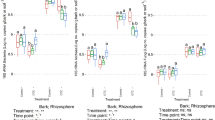Abstract
Conventional willow control in wetland and riparian areas of New Zealand is undertaken using cut-stump and/or drill and injection application of glyphosate. The presence of herbicide residues in catchment water supplies has seen the investigation of non-chemical alternatives to poplar and willow control in Auckland water catchment areas. We have demonstrated, in glasshouse trials, the efficacy of an aqueous, gel-based formulation of Chondrostereum purpureum to control the regrowth of crack and grey willow (Salix fragilis and S. cinerea). Chondrostereum purpureum isolate ICMP 16392 (isolated from a Prunus sp.) produced the fastest biomass accumulation in liquid culture. Crack willow was significantly more susceptible to cut-stump infection by C. purpureum than grey willow in the glasshouse trial at the end of the 23-week period. Two different formulations were tested; at the end of the trial, there was no significant difference between them with respect to monthly biomass accumulation. Successful field applications of C. purpureum through cut and paste and drill and injection were confirmed by the presence of fruiting bodies on both treated species. Resprouting ability as measured by shoot number was significantly lower on C. purpureum inoculated stumps.




Similar content being viewed by others
References
Auckland Council (2012) Pest management plan—management guidelines. Auckland Regional Council, Auckland
Benachour N, Séralini GE (2009) Glyphosate formulations induce apoptosis and necrosis in human umbilical, embryonic and placental cells. Chem Res Toxicol 22:97–105
Boyetchko SM (2005) Biological herbicides in the future. In: Ivany JA (ed) Weed management in transition: topics in Canadian weed science. Canadian Weed Science Society, vol 2. Sainte-Anne-de-Bellevue, Quebec, pp 29–43
De Laender F, Van der Brink PJ, Janssen CR (2011) Functional redundancy and food web functioning in linuron-exposed ecosystems. Environ Pollut 159:3009–3017
Dewey SL (1986) Effects of the herbicide on aquatic insect community structure and emergence. Ecology 67:148–162
Eckramoddoulah AKM, Shamoun SF, Wall RE (1993) Comparison of Canadian isolates of Chondrostereum purpureum with respect to temperature response, virulence and protein profiles. Can J Plant Pathol 15:7–13
Fick WH, Geyer WA (2010) Cut-stump treatment of saltcedar (Tamarix ramoisissima) on the Cimmaron National Grasslands. Trans Kans Acad Sci 113:223–236
Graymore M, Stagnitti F, Allison G (2001) Impacts of atrazine in aquatic ecosystems. Environ Int 26:483–495
Payne NJ, Feng JC, Reynolds PE (2006) Off-target deposits and buffer zones required around water for aerial glyphosate applications. Pestic Sci 30:183–198
Sachs CE (1993) Growing public concern for pesticides in food and water. In: Pimentel D, Lehman H (eds) The pesticide question: environment, economics, and ethics. Chapman and Hall, New York, pp 23–64
Shamoun SF, Ramsfield TD, Hintz WE (2002) Development of Chondrostereum purpureum as a biocontrol agent for red alder (Alnus rubra) in utility rights-of-way. Phytopathology 86(11 suppl):S22
Spiers AR (1985) Factors affecting basidiospore release by Chondrostereum purpureum in New Zealand. Eur J For Pathol 15:111–126
Wall RE (1997) Fructification of Chondrostereum purpureum on hardwoods inoculated for biological control. Can J Plant Pathol 19:181–184
Wan MT, Kuo J-N, MacPherson B, Pasternak J (2006) Triazine and metolachlor herbicide residues in farm areas of the Lower Fraser Valley, British Columbia, Canada. J Environ Sci Health A Pestic Food Agric Wastes 41:855–867
Acknowledgments
We thank Salusi Toalima for field assistance, Nick Waipara and Kate Leggett (Auckland Council) for research advocacy, financial support for Gabriela Ezeta (via 2012, “Summer Studentship”) and access to Hunua Catchment for preliminary field trials in 2008–2009. Dr Simon Fowler provided funding under the Beating Weeds II Programme (Government Core-funded), and the pioneering research of Sue Bunning is acknowledged.
Author information
Authors and Affiliations
Corresponding author
Rights and permissions
About this article
Cite this article
Bellgard, S.E., Johnson, V.W., Than, D.J. et al. Use of the silverleaf fungus Chondrostereum purpureum for biological control of stump-sprouting, riparian weedy tree species in New Zealand. Australasian Plant Pathol. 43, 321–326 (2014). https://doi.org/10.1007/s13313-014-0273-z
Received:
Accepted:
Published:
Issue Date:
DOI: https://doi.org/10.1007/s13313-014-0273-z




